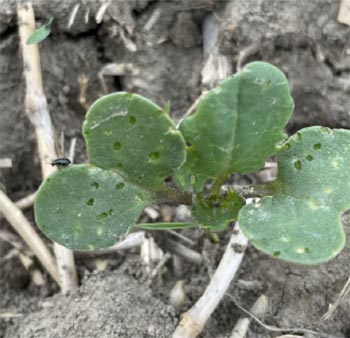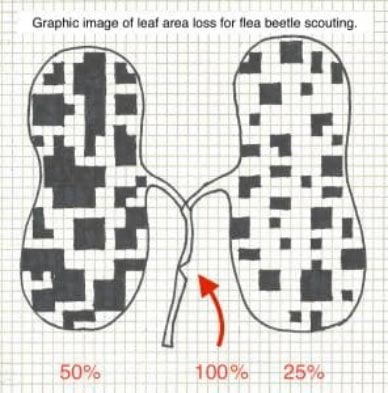Agronomy Update
 Grasshopper Nymphs Spotted in Williston
Grasshopper Nymphs Spotted in Williston
Scouting fields on 5/17 we found some grasshopper nymphs in the grassy area neighboring the field and feeding damage on the weed leaves. No damage was observed in the fields that we scouted. Keep an eye on your field edges in the newly emerging crop to catch damage before it becomes wide-spread. We still have a supply of Lumivia insecticide seed treatment which provides 45 day grasshopper suppression so consider treating your later planted crops.
Early Season Foliar Disease in Winter Wheat
Fungal pathogens are beginning to infect winter wheat causing foliar disease. Early season moisture allowed pathogens that overwinter as black fruiting structures (middle picture below) on the crop stubble to generate spores and infect the winter wheat crop. Some level of foliar disease in the lower canopy is not unusual but when symptoms start to spread up the canopy (picture below) and there is cool, wet weather in the forecast that is cause for concern. 
When disease symptoms are visible in the field and risk factors are present: 1) wheat was planted onto wheat stubble and 2) cool, wet weather is in the forecast, growers should strongly consider applying a foliar fungicide. There are many fungicide options available for control of the problematic diseases (Stangnospora nodorum blotch, Septoria tritici blotch, and tan spot). One of the most commonly used products, Tilt (propiconazole), applied at 4 oz/ac provides very good control of these three diseases along with rust. A handy table is available from the Crop Protection Network that lists fungicide efficacy for control of wheat diseases and the link is below in our resources section.
Dr. Audrey Kalil, Agronomist/Outreach Coordinator
Grass Weed Control in Pea and Lentil
Critical weed free periods are two weeks post emergence in peas, and 5-10 nodes in lentils. Weed competition can cause significant yield loss if not controlled during this time.

Early planted lentils and peas are between 1.5 and 2 inches tall in some fields (one to two nodes) and grass weeds are beginning to emerge. The picture below was taken on 5/15.
Unless you are planting Clearfield® lentils, your grass control herbicides are all group 1. This is the same mode of action as a lot of the grass herbicides we have been using for close to twenty years in our cereals. Resistance to group 1 herbicides has been documented in green foxtail and wild oat in ND and we need to be proactive in managing this issue.
For that reason, we are recommending a tank mix of both group 1 options we have available in pulses for grass control; clethodim and quizalofop, along with an oil to help get the herbicides into the weeds. While clethodim and quizalofop are both group 1 herbicides, one is a “fop” and one is a “dim” and they work a little different in how they kill the weed. Combining these products will provide better control and hopefully slow the accumulation of herbicide resistant weed populations in your fields. For brand names, we are using Section Three which is a 3lb Clethodim product and Targa for our quizalofop. Combined, you can spray both products for a little over $7 per acre without factoring in the oil. While it can be a temptation to use the cheapest generic clethodim you can ($2/ac), I always say that the most expensive herbicide application is the one that doesn’t work.
Comparing $2 with $7 per acre into the cost of production of a 30 bu/ac yield, the difference is $0.16 per bushel. If you have a weed problem when your generic does not work, it could cost you many bushels per acre. The main difference in generics are the surfactants that help get the actives into the weeds and reduce the period of time to rain fast. The surfactants are not regulated or stated on the label, so that is why you get what you pay for in terms of product efficacy. Our main grassy weeds that we are targeting will be wild oats, green foxtail, quackgrass, barnyard grass and volunteer cereals and we have had really good luck with this tank mix.
Planning ahead in your crop rotation will help preserve the group 1 products we rely upon in our pulse crops and Liberty Link canola. Discover, Puma, and Axial are all group 1 herbicides and we have seen increased tolerance and resistance for close to ten years now with these herbicides. In cereals we need to use group 2 herbicides like Everest, Varro and Huskie Complete so we don’t completely lose the group 1s. Using the Roundup Ready systems with canola or soybeans also gives us a break from both group 1 and group 2 grass herbicides. Glufosinate tolerant Liberty Link systems in canola still rely on adding group 1 grass herbicides, so keep that in mind selecting canola varieties. No matter which products you decide to use, we want to stress the importance of rotating both your modes of action and crops. We don’t have much for new and have been using the old for many years now. Reach out if you have any questions.
John Salvevold, Agronomy Division Manager
Approaching Winter Wheat Top-Dress
 For those of you who have winter wheat, a critical time is coming soon, the 5th leaf stage prior to jointing. It’s at this point that yield potential is still to be determined as the wheat head is setting how many kernels per spike it can potentially fill. It’s important to keep ample nitrogen supplied to the wheat plants at this stage. But what if you miss this stage? Is it worth still going out and top-dressing nitrogen? The answer is yes! Even though the wheat plant may be advancing in stage, does not mean it will not be worth fertilizing.
For those of you who have winter wheat, a critical time is coming soon, the 5th leaf stage prior to jointing. It’s at this point that yield potential is still to be determined as the wheat head is setting how many kernels per spike it can potentially fill. It’s important to keep ample nitrogen supplied to the wheat plants at this stage. But what if you miss this stage? Is it worth still going out and top-dressing nitrogen? The answer is yes! Even though the wheat plant may be advancing in stage, does not mean it will not be worth fertilizing.
If favorable conditions persist and the true potential is there for high yields, added nitrogen will be needed to fill wheat kernels out their fullest potential. So just remember this: nitrogen added at or before the 5th leaf has the potential to add yield to your wheat crop and nitrogen after 5th leaf will help preserve the yield potential of your wheat crop.
Kyle Okke, Crop Consultant
Update on Flea Beetle in Canola
 Check out the latest version of the NDSU Crop and Pest Report (click here) for updated information on flea beetle management. They are active in our area (picture to the right taken 5/15 by Fairview Agronomist, Jenna Rust) and action needs to be taken quickly once damage has reached action thresholds. If you are seeing damage above the 25% threshold and are beyond the 14-21 window of protection from the seed treatment you can tank mix the insecticide with your first glyphosate application. To give you an idea of cost, one of the more economical options—Lamda CY EC RUP is applied at a rate of 3.84 oz per ac and costs $1.56 per acre.
Check out the latest version of the NDSU Crop and Pest Report (click here) for updated information on flea beetle management. They are active in our area (picture to the right taken 5/15 by Fairview Agronomist, Jenna Rust) and action needs to be taken quickly once damage has reached action thresholds. If you are seeing damage above the 25% threshold and are beyond the 14-21 window of protection from the seed treatment you can tank mix the insecticide with your first glyphosate application. To give you an idea of cost, one of the more economical options—Lamda CY EC RUP is applied at a rate of 3.84 oz per ac and costs $1.56 per acre.

Resources
Fungicide Efficacy for Control of Wheat Diseases >Montana State Guide to Lentil Weed Management >
Pulse Crop Growth Staging for In Crop Weed Management >
Scouting For and Managing Grasshoppers >